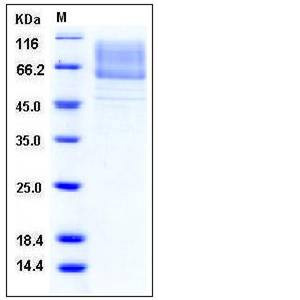Mouse LIMP-2 / SCARB2 / CD36L2 Protein (His Tag)
9330185J12Rik,Cd36l2,LGP85,LIMP-2,MLGP85
- 100ug (NPP3393) Please inquiry
| Catalog Number | P50052-M08H |
|---|---|
| Organism Species | Mouse |
| Host | Human Cells |
| Synonyms | 9330185J12Rik,Cd36l2,LGP85,LIMP-2,MLGP85 |
| Molecular Weight | The recombinant mouse SCARB2 consists of 417 amino acids after removal of the signal peptide and has a predicted molecular mass of 47.8 kDa. In SDS-PAGE under reducing conditions, the apparent molecular mass of rmSCARB2 is approximately 60-90 kDa due to glycosylation. |
| predicted N | Arg 27 |
| SDS-PAGE |  |
| Purity | > 90 % as determined by SDS-PAGE |
| Protein Construction | A DNA sequence encoding the extracellular domain of mouse SCARB2 (NP_031670.1) (Met 1-Thr 432) was fused a polyhistidine tag at the C-terminus. |
| Bio-activity | |
| Research Area | Microbiology |Pathogenic microorganism |viruses |animal virus |viral illness |Viral gastroentertis | |
| Formulation | Lyophilized from sterile 50mM Tris-Citrate, 0.3M NaCl, pH 6.5 1. Normally 5 % - 8 % trehalose, mannitol and 0.01% Tween80 are added as protectants before lyophilization. Specific concentrations are included in the hardcopy of COA. |
| Background | Lysosomal Integral Membrane Protein II (LIMPII), also known as SCARB2, LPG85, and CD36L2, is a type I II multi-pass membrane glycoprotein that is located primarily in limiting membranes of lysosomes and endosomes on all tissues and cell types so far examined. This protein may participate in membrane transportation and the reorganization of endosomal/lysosomal compartment. LIMPII is identified as a receptor for EV71 (human enterovirus species A, Enterovirus 71) and CVA16 (coxsackievirus A16) which are most frequently associated with hand, foot and mouth disease (HFMD). Expression of human LIMPII enables normally unsusceptible cell lines to support the viruses’ propagation and develop cytopathic effects. In addition, LIMPII also has been shown to bind thrombospondin-1, may contribute to the pro-adhesive changes of activated platelets during coagulation, and inflammation. Deficiency of the protein in mice impairs cell membrane transport processes and causes pelvic junction obstruction, deafness, and peripheral neuropathy. |
| Reference |
